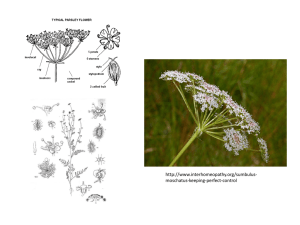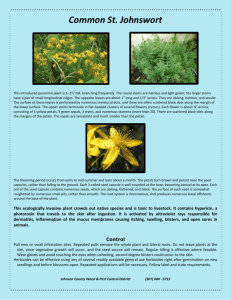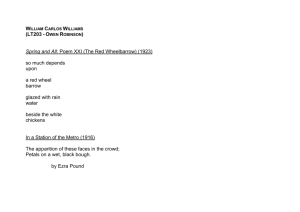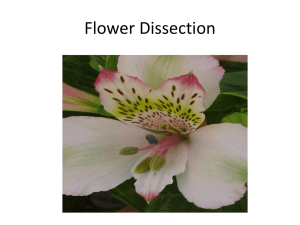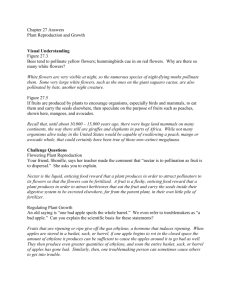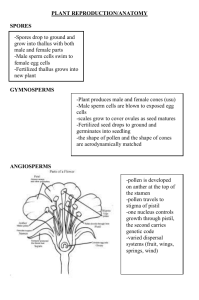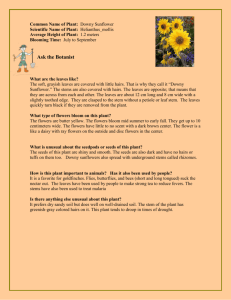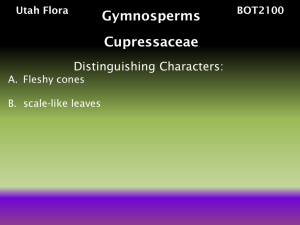Dichotomous Key Lab Activity
advertisement
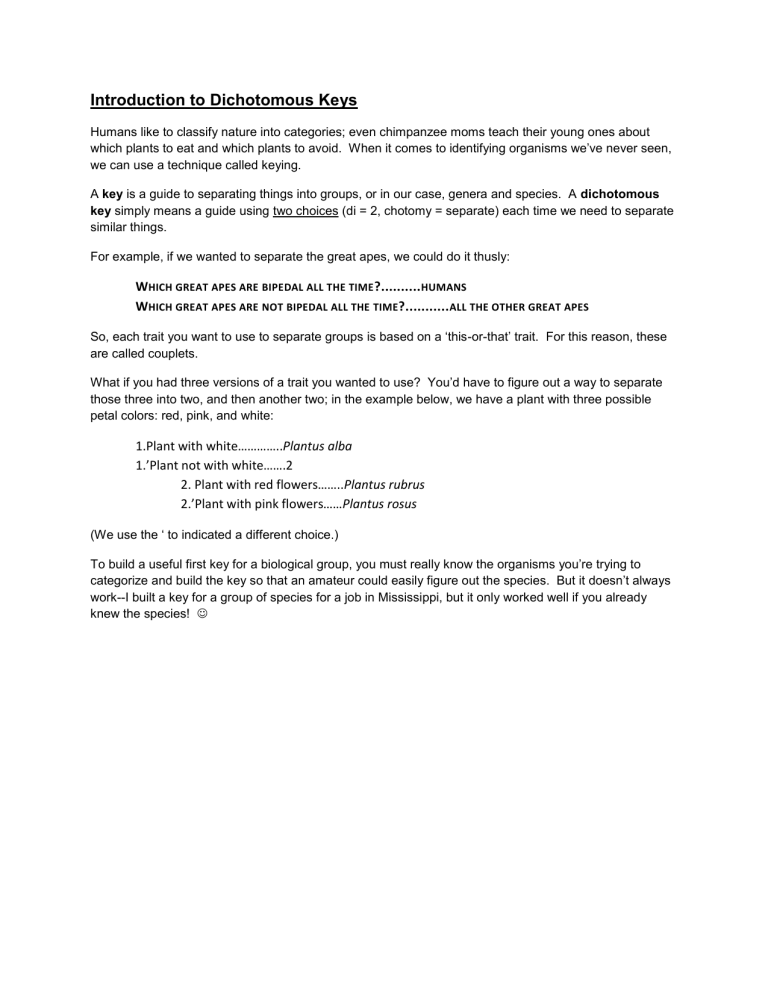
Introduction to Dichotomous Keys Humans like to classify nature into categories; even chimpanzee moms teach their young ones about which plants to eat and which plants to avoid. When it comes to identifying organisms we’ve never seen, we can use a technique called keying. A key is a guide to separating things into groups, or in our case, genera and species. A dichotomous key simply means a guide using two choices (di = 2, chotomy = separate) each time we need to separate similar things. For example, if we wanted to separate the great apes, we could do it thusly: WHICH GREAT APES ARE BIPEDAL ALL THE TIME ?.......... HUMANS WHICH GREAT APES ARE NOT BIPEDAL ALL THE TIME?........... ALL THE OTHER GREAT APES So, each trait you want to use to separate groups is based on a ‘this-or-that’ trait. For this reason, these are called couplets. What if you had three versions of a trait you wanted to use? You’d have to figure out a way to separate those three into two, and then another two; in the example below, we have a plant with three possible petal colors: red, pink, and white: 1.Plant with white…………..Plantus alba 1.’Plant not with white…….2 2. Plant with red flowers……..Plantus rubrus 2.’Plant with pink flowers……Plantus rosus (We use the ‘ to indicated a different choice.) To build a useful first key for a biological group, you must really know the organisms you’re trying to categorize and build the key so that an amateur could easily figure out the species. But it doesn’t always work--I built a key for a group of species for a job in Mississippi, but it only worked well if you already knew the species! DICHOTOMOUS KEY PRACTICE 1. 1. Examine the various hardware given to you. 2. Write down at least 5 traits that are different amongst various pieces. Trait 1:__________________________________ Trait 2: :__________________________________ Trait 3: :__________________________________ Trait 4: :__________________________________ Trait 5: :__________________________________ 3. The first step in building a key is to find a trait that separates out two large groups from your original group. Which of your traits does that?________________________________ 4. Now, find another trait, one in each group, which can separate each group into two further groups. Which trait did that?_________________________________ 5. Keep going until all the various pieces are separated into individual (or nearly so) units. The next step is to write a dichotomous key for your pieces. Begin with the first trait you used earlier, for example: 1. Item is more than 2 inches long………..2 1. Item is less than 2 inches long…………….3 6. Keep going until you’ve finished; write your key below: DICHOTOMOUS KEY PRACTICE 2 (WORKING IN PAIRS IS FINE ). Go collect 5 random flowering plants from outside and use the keys below to find the families for these plants. Please note that the keys below are quite generalized, so you may not be able to find your particular plant’s family, but it’s the practice that counts. Plant #1’s family:________________________________ Plant #2’s family:________________________________ Plant #3’s family:________________________________ Plant #4’s family:________________________________ Plant #5’s family: :________________________________ Quick Key for Families 1. Plants without flowers, but with needle or scale leaves, cones may be present………………………Key 1 1.’ Plants with flowers, netted or parallel leaf veins……………………Key 4 Key 1 1. Cones present, wood present…………………………Key 2 1.’ Cones absent, no wood……………………………….Key 3 Key 2--Gymnosperms 1. Leaves fan-shaped with dichotomous veins…………………Ginkgo biloba 1.’ Leaves not fan-shaped………………2 2. Leaves scale-like, cones seem bluish-gray & berry-like…………………Eastern Red Cedar 2.’ Leaves needle-like……………………………………..3 3. Leaves arising from obvious fascicles (short shoots)……………….Pine 3.’ Leaves not arising from fascicles……………………………5 4. Leaves divided into small, feathery leaflets………………..Bald Cypress 4.’ Leaves not divided; instead, tough, narrow………………...Spruce Key 3—Ferns or Lower Vascular Plants 1. Frond divided into many leaflets; spores present on underside of leaflets……………..Fern 1.’ No frond present; lateral sporangia present on stem, not leaf……..Lower Vascular Plant Key 4—Flowering Plants 1. Plant a tree or woody vine…………………………….Key 5 1.’ Plant not a tree or woody vine; herbaceous………...Key 6 Key 5—Woody Trees, Vines 1. Plant a tree……………………………….Key 7 1.’ Plant a vine………………………………Key 8 Key 6—Non-woody flowering plants 1. Plant with parallel leaf veins, sepals/petals in 3’s or multiples ………..Key 9--Monocots 1.’ Plant with netted leaf veins, sepals/petals in 4’s, 5’s, or multiples ……Key 10--Dicots Key 7—Woody flowering trees 1. Leaves compound……………………..2 1.’ Leaves simple……………………….5 2. Stems with prickles; small trees & shrubs; 5-petals……….Rosaceae 2.’ Stems not as above……………………3 3. Small shrubs/trees; leaflets narrow & serrated; stems 1-3” in diameter…Anacardiaceae 3.’ Large trees, often >1’ in diameter……..4 4. Leaves opposite……………Oleaceae 4.’ Leaves alternate…………..Juglandaceae 5. Leaves serrated, cord-like veins, small, rounded green fruits….Celtidaceae 5.’ Leaves not as above………………..6 6. Leaves with base sides not matching……………….Ulmaceae 6.’ Leaves with matching bases……….7 7. Leaves with various shapes on same tree………….8 7.’ Leaves with consistent shapes on same tree………9 8. Leaves simple, bilobed, and trilobed; margins serrated……….Lauraceae 8.’ Leaves as above but margins smooth…………………………..Moraceae 9. Leaves deeply divided (but not compound)………..10 9.’ Leaves not deeply divided…………………………..11 10. Leaves longer than wide, with rounded, deeply divided lobes, some with spines……Fagaceae 10.’ Leaves as above but appear palmately compound………….Sapindaceae 11. Stems with spines/thorns…………….Saxifragaceae 11.’ Stems without spines/thorns…………12 12. Stems with chambered piths, large purple berries……..Phytolaccaceae 12.’ Stems not as above……………13 13. Leaves lobed (not deeply); veins palmate…………..14 13.’ Leaves not lobed……………………………………….15 14. Leaves usually with 3 large lobes, leaf more than 6” wide…….Platanaceae 14.’ Leaves usually with 3-5 small lobes, leaf less than 6” wide……Sapindaceae 15. Leaves triangular…………………16 15.’ Leaves not triangular………………17 16. Leaves with serrated margins, tree near water; seeds in cottony mass…….Salicaceae 16.’ Leaves can be serrated (sometimes doubly), bark can peel……..Betulaceae 17. Leaves very narrow, linear, tree in or near water………….Salicaceae 17.’ Leaves not as above………….18 18. Leaves extremely large (>1’ long) and heart-shaped; fruits are long, brown capsules…Bignoniaceae 18.’ Leaves not as above………19 19. Flowers with 3 sepals, 6 petals; fruit large, light green, edible……Annonaceae 19.’ Trees not as above………20 20. Leaves longer than wide but not narrow; very waxy; carpels arranged in cone…Magnoliaceae 20.’ Leaves not as above…………..21 21. Leaves very small, dark maroon, thorns present…………..Berberidaceae 21.’ Leaves green, veins parallel margin, small flowers………Cornaceae Key 8—Flowering Woody Vines 1. Flower orange, tubular, 5 lobed, leaves compound…………Bignoniaceae 1.’ Flowers not apparent…………..2 2. Leaves palmately compound with leaflets 5……..Rosaceae 2.’ Leaves not as above……….3 3. Leaves compound with 3 leaflets…….Anacardiaceae 3.’ Leaves not compound; veins parallel; spines present……..Smilacaceae Key 9—Monocots 1. Plants grass-like with very small flowers…………………..Key 11 1’. Plants may be grass-like but flowers are obvious…………2 2. Sepals/Petals recognizable as such…………………….3 2.’ Sepals/Petals modified into other structures…………..4 3. Stamens 6, ovary superior, sepals like petals……………………………..Liliaceae 3.’ Stamens 3, ovary inferior, sepals point downwards………………………Iridaceae 4. Sepals green, petals blue/purple, stamens 6, superior ovary……Commelinaceae 4.’ Sepals pigmented, stamens 3, ovary inferior………Orchidaceae Key 10—Dicots 1. Flowers regular………………….Key 12 1.’ Flowers irregular………………..Key 13 Key 11—Grass-like flowering plants 1. Stems triangular……….Cyperaceae 1.’ Stems round……………2 2. Female flowers in large ‘corndog’ like clusters at top of stem….Typhaceae 2.’ Female flowers not as above………3 3. Leaf bases surround stem but aren’t fused; stems mostly hollow……..Poaceae 3.’ Leaf bases not as above; stems not hollow…….Juncaceae Key 12—Dicots with regular (not fused or strangely-shaped) flowers 1. Flower parts in 4’s or multiples……………………2 1.’ Flower parts in 5’s or multiples……………………4 2. Petals separate, in cross-shape, 6, stamens, ovary superior………………Brassicaceae 2.’ Petals fused, in tube or connected to tube, ovary inferior…………….3 3. Petals lobed, sepals lobed, stigma 4-lobed & cross-shaped……………Onagraceae 3.’ Petal tube lobed, sepals fused, stigma not cross-shaped………………Rubiaceae 4. Ovary superior………………………….5 4.’ Ovary inferior……………………………7 5. Flowers with stamens fused to style…………………Malvaceae 5.’ Flowers with stamens not fused to style…………….6 6. Stems with prickles…………………Rosaceae 6.’ Stems without prickles……………..7 7. Flowers in umbels or compound umbels……………Apiaceae 7.’ Flowers not in umbels…………………………….8 8. Flowers fused into tube …………9 8.’ Flowers not fused…………………10 9. Stem a vine…………………………………… ……………. Convolvulaceae 9.’ Stem not a vine; spines present on leaves; leaves alternate……… Solanaceae 10. Sepals absent; petals enlarged as membranes (often); 6-9 stamens…….Polygonaceae 10.’ Flowers not as above……………………..11 11. Tubular flowers; ovary deeply 4-lobed; single style………………….Boraginaceae 11.’ Flowers not as above…………………12 12. Leaves alternate; stamens 8-10; 5 sepals united at base……………………….Ericaceae 12.’ Leaves opposite; 5-10 stamens; petals often notched……………………Caryophyllaceae Key 13—Irregular flowers with 5 petals or lobes 1. Petals fused……………………….2 1.’ Petals not fused………………….3 2. Stems squarish; aromatic leaves; petal lobes form upper/lower lips……..Lamiaceae 2.’ Stems not square; leaves not aromatic; petals not in lips…………….Scrophulariaceae 3. Sepals fused at base; stamens many; leaves trifoliate or compound…….Fabaceae 3.’ Sepals not fused at base; stamens 5; leaves heart- or triangular-shaped….Violaceae Families with unusual flower arrangements: Heads—disk and ray flowers usually present; green bracts underneath head…Asteraceae Floral cup—cyathium—ovary 2- or 3-lobed; latex often present…………….Euphorbiaceae Flowers in rounded clusters; latex present; sepals point down, petals up….Asclepiadaceae Flowers vary greatly; many superior carpels; sepals replace petals…….Ranunculaceae
